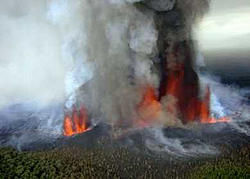
© planetdiary.comPrevious eruption of Mt. Nyamuragira
Previous eruptions in recent times may be dwarfed by the expected next eruption of Mt. Nyiragongo, which towers over the Eastern Congolese city of Goma. Nine years ago, in January 2002, when the region's most active volcano erupted, the reportedly rather liquid lava swiftly covered a sizeable part of the city and even brought air transport to a complete standstill, when a portion of the runway was covered by lava, which when finally cooled down, was measured to be 6 and more feet thick and as wide as a kilometer, leaving total destruction in its wake and making over 120,000 residents homeless.
The eruption then reached as far as Lake Kivu and only a major effort supported by the UN and international partners made the airport somehow usable again, albeit with a still shortened runway, which makes the use of larger aircraft impossible and impacts on the operations of the airport even with smaller jets. Accidents have, in fact, been recorded at Goma attributed at the shortened runway making every landing and take off an adventure of sorts.
An earlier major eruption in 1977 also caused similar havoc, but population numbers were considerably less back then and the main path of the lava was not directed frontally against Goma. There are reportedly only two main exit routes for the lava, as researchers have established and, therefore, the chance of Goma being hit again during the next eruption is 50/50.
Since the 2002 eruption and after the volcano had quieted down again, entrepreneurs even introduced guided tours to the volcano's peak, allowing visitors to have a look into the lava lake, ignoring warnings from volcanologists to stay well clear of the crater. While in the past, ahead of major eruptions, earthquakes and seismic events indicated increased activity of the volcano, the absence of monitoring equipment is hampering the ability of researchers to adequately monitor the mountain and predict imminent eruptions. Neither the volcano operators nor the population at large seems overly concerned at this stage, in spite of recent pictures being taken from aircraft flying over the crater, showing it once again filling up with enormous quantities of lava.
A few months ago it was reported here that the lava's reflections on low clouds could be seen all the way into Uganda, again underscoring that there is indeed now a growing possibility of another upcoming eruption, many of which in the recorded history of the volcano have come at 10-year intervals.
The African Rift Valley, which extends from the Red Sea across much of Africa to Malawi, has always been an active seismological zone - as another active volcano, Mt. Ol Donyo Lengai in Tanzania demonstrates - but of late, disquieting reports have emerged that the underwater rip in the Red Sea seems to be widening, as minor eruptions have been reported from the border area between Ethiopia and Djibouti. It is there that the ground has also lowered and subsequently seismic monitoring has been substantially increased to provide early alerts of imminent developments.
In the Eastern African part of the Rift Valley, and especially for Mt. Nyiragongo, this does not seem to be the case at present, however, leaving the populations near such volcanos at greater risk. With no meaningful evacuation plans in place, leave alone the assets in place and the resources available, the Goma volcano can be considered a disaster in waiting. Should, in fact, the airport during a future eruption be closed again, feasible evacuations and the arrival of supplies and equipment will then only be able to reach Goma by road from Rwanda or else across the lake, where shipping capacity is also minimal.
can someone please explain what a volcano operator is
many thanks in advance